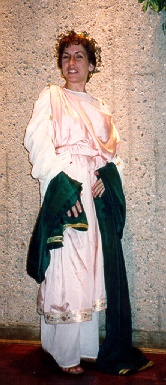Articles
I am sometimes asked about articles I've published (but not that often!). I thought it would be handy to post them here.
All articles are copyright and may NOT be reproduced elsewhere without EXPRESS PERMISSION.
- Lindsey Davis: An Interview with the Author of Silver Pigs.
- Fluent Latin
- A Ghost's Tale: Musings on the Film Scenario
- Just Charming: Tapping into the Latin Magic of Harry Potter
- Audiocassettes, Anyone?
- Twice a First Year Teacher
- Leafing Out: State Vice Presidents, the CPL and You
- Validating Spanish in the Latin Classroom
- Review: Tonight They All Dance
- Review: Arbor Alma: The Giving Tree in Latin
- Review: What Will I Eat? Quid Edam?
- Getting on Target: An Analysis of a Middle School Classroom
- Grammar and CLC: Keeping it in Context
- National Latin Teacher Recruitment Week: A Look Back
- CarPe Latinam: CPL's Tips for the Latin Classroom
- CarPe Latinam II
- CarPe Latinam III
- Survey Results from the 2nd Annual National Latin Teacher Recruitment Week
CarPe Latinam CPL’S TIPS FOR THE LATIN CLASSROOM
(This article appeared in the CAMWS Newsletter, Fall 2003 issue/)
In Latin for the 21st Century1 Rick LaFleur advises teachers to remember their SANDALS while in Rome (i.e., in the microcosm of Rome that is your Latin classroom): Spectate Audite Nunc Dicite Agite Legite Scribite. This acronym, SANDALS, is an extremely useful guide for activities in the Latin classroom. It reminds us of all the basic language learning skills, and in the order in which we naturally employed them as young children in learning our own native language, for to fully learn a new language, one first looks and listens to the target language, then one speaks, follows directions/acts, reads and finally writes in the target language. In this new CPL column, I would like to explore different activities that address one or more of the pedagogical goals represented in this acronym.
Build-A-Sentence is an activity for beginning Latin classes that I learned from Joe Davenport at an American Classical League Institute a few years ago. This is a useful activity to promote composition skills in Latin and reinforce syntactic meanings of morphological endings—and to have fun while doing it. Before class prepare two complete sets of large index cards with the following Latin words, singular on the front, plural on the back: ancilla/ancillae, servus/servi, canis/canes; ancillam/ancillas, servum/servos, canem/canes; portat/portant, videt/vident, est/sunt. These two sets of cards are then spread out at the front of the room, either on the chalk trays or a table. Divide the class into two teams to compete for points. Three students from each team will go to the front of the room. The teacher then calls out a simple sentence in English such as “The slave sees the dog.” The first team to hold up the correct cards in good Latin word order (servus canem videt) receives the point. Before the current set of students return to their seats, have them freeze with their cards in the air in order to discuss why one team’s sentence is correct and why the other team’s sentence is incorrect. Have those students sit down and repeat with a new set of students from each team.
With such a limited vocabulary, many of the sentences you create will be silly or nonsensical: “The dog carries the slave girl,” “The slave is a dog,” “The slaves are slavegirls,” etc. Of course, this lack of choice helps to keep the tone of the exercise lighthearted. Halfway through class, stop the game and then provide the students with a list of the same English sentences on an overhead or worksheet to translate into Latin. This last step provides individual accountability after the comfort of working cooperatively in a group.
Build-A-Sentence addresses Legite (reading the composed sentences on the cards) and Scribite (writing or composing sentences in Latin). Moreover, for the younger student this exercise provides physical activity as well as a transition from the comfort of group work to individual accountability. If you like the idea of SANDALS, you might want to download the striking, full color SANDALS poster available at the new CPL website at www.camwscpl.org. For a professional look, print it on high gloss paper. Do you have a great activity that demonstrates that you and your students remember your SANDALS while in Rome? Please send it to me at ginlindzey@lindzey.us, or write to me at Porter Middle School, 2206 Prather Lane, Austin TX 78704.
--Ginny Lindzey, Chair, Committee for the Promotion of Latin, Porter Middle School, Austin, Texas
1 LaFleur, Richard A., ed. Latin for the 21st Century (Glenview, Illinois: Addison-Wesley Educational Publishers Inc, 1998). pp 320. ISBN 0-673-57608-6. Available only through Prentice Hall at www.phschool.com for $28.97.
copyright, Ginny Lindzey, 2003
June 8 , 2004
